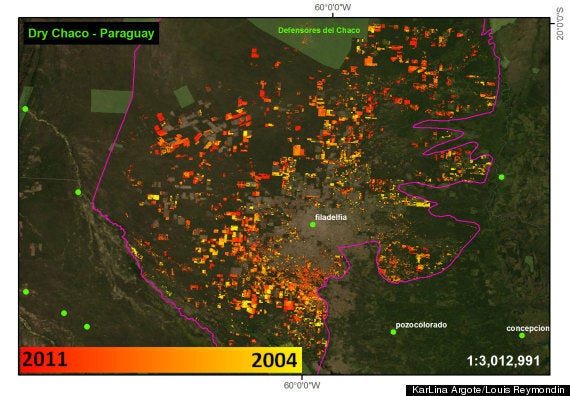The first ever satellite system to monitor deforestation across Latin America in near-real time has revealed that in parts of Colombia, tree-felling has increased by a staggering 340 per cent since 2004.
It also indicates that a million hectares of forest have been lost in the richly diverse Gran Chaco region of Paraguay.
The system was developed by an international team of researchers in the UK – from King's College London - Colombia, the USA and Switzerland.

This shows deforestation around the Dry Chaco of Paraguay from 2004 to 2011
It’s known as Terra-I and is being launched this week in time for the Rio+20 UN environment conference, and is soon to be expanded to cover all tropical regions.
Although Brazil has had a sophisticated near real-time deforestation monitoring system in place since 2008, until now there has been no equivalent for the rest of Latin America.
Terra-i has been developed to monitor changes in land cover every 16 days and for every 250 metres on the ground, in order to help national governments, conservation organisations and those implementing climate-related policy to assess recent trends in deforestation and emerging hotspots of change.
The system uses data supplied by Nasa's MODIS satellite sensor and is the result of collaboration between King’s College London, the International Center for Tropical Agriculture in Colombia, The Nature Conservancy in the USA and South America, the School of Engineering and Management of Vaud in Switzerland.
Deforestation can lead to widespread loss of biodiversity and also impacts the 'ecosystem services' that foster a stable climate and secure freshwater supplies.
However, in many parts of the world the scale and pattern of deforestation is infrequently and inconsistently monitored and this makes management of change very difficult.
Huge volumes of data need to be processed to detect land cover change accurately.
Moreover, separating real human-induced changes, such as deforestation, from changes brought about by natural seasonality and by droughts, floods or persistent cloud cover, has made the development of an operational monitoring system a real challenge.
The availability of MODIS imagery means that assessment of land cover change can be made in a geographically consistent manner between countries and also updated frequently.
The development of the Terra-i system was led Louis Reymondin, PhD student in the Department of Geography at King's College London, supervised by Dr Mark Mulligan.
“We developed a computational neural network and 'trained' it with data from 2000-2004 to recognise the normal changes in vegetation greenness due to seasonal variation in rainfall in different areas,” said Dr Mulligan, who is attending the Rio+20 conference this week.
“The network now recognises where and when greenness suddenly changes well beyond these normal limits as a result of deforestation. The system runs on data for every 250 square metres of land from Mexico to Argentina shortly after the data comes in from MODIS and highlights every 16 days the pixels that significantly change, writing these results to Google Maps for easy visualisation,” he said.
SEE ALSO:
Olympics 2012: Rio Tinto, Mining Company Responsible For Medals, Faces Lawsuit Over Green Record
Preliminary data from Terra-i show that in Caquetá, Colombia for example, deforestation grew from around 4,880 hectares in 2004 to 21,440 in 2011, up by 340 per cent.
Deforestation has grown significantly in the buffer zones of the Chiribiquete National Park where deforestation rates increased by 196 per cent from 2010 to 2011.
The Gran Chaco in Paraguay is the second largest forested area in South America. Terra-i found that between 2004 and 2010, over a million hectares of this area was deforested with a peak in 2009 of 454,700 hectares.
'As we approach Rio+20 in which the world will define the targets that will guide us along the road to a more sustainable development, it is critical that we deploy the appropriate tools to carefully monitor and manage our landscapes,” said Dr Mulligan.
“We need to ensure that we maintain enough farmland to feed the nine billion to come but we must also have protected natural landscapes that provide clean water, a stable climate, a refuge for biodiversity and space for increasingly urbanised populations to experience and appreciate the wonders of nature.
“Achieving the right balance between intelligently intensive agriculture and protected natural environments across the world will be fundamental to achieving truly sustainable development and requires sophisticated, geographically detailed and timely tools such as Terra-i to support appropriate policy and decision-making.”